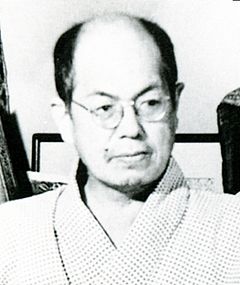- Saneatsu Mushanokōji
-
Saneatsu Mushanokōji 
Saneatsu MushanokōjiBorn 12 May 1885
Tokyo, JapanDied 9 April 1976 (aged 90)
Tokyo, JapanOccupation Writer Genres novelist
InfluencesSaneatsu Mushanokōji (武者小路 実篤(實篤) Mushanokōji Saneatsu, 12 May 1885– 9 April 1976) was the pen name of a Japanese novelist, playwright, poet, artist and philosopher active during the late Taishō and Shōwa periods of Japan. He was also sometimes known as Mushakōji Saneatsu, other pen-names included Musha and Futo-o.
Contents
Early life
Born in Tokyo as the 8th son of Viscount Mushanokōji Sanezane, Saneatsu’s father died when he was age 2, and he was raised largely by his mother. Saneatsu was very frail and sickly as a youth, and unable to compete in physical activities in the Peers’ School. To compensate, he developed his debating skills, and began to develop an interest in literature. While at the Peers’ School, he became friends with Shiga Naoya. His uncle introduced him to the Bible and the works of Tolstoy. He enrolled in the philosophy department of Tokyo Imperial University, but left without graduating in 1907 to form a literary group with Kinoshita Rigen, Shiga Naoya, Arishima Takeo and Ogimachi Kinzaku called Jūkokakai (The Fortnight Club). This group evolved into the Shirakaba (White Birch) literary coterie, which first published the Shirakaba literary magazine in 1910.
Literary career
Mushanokōji was a key member of Shirakaba, and published his work Omedetaki Hito (Good Natured Person) in its magazine in 1910. This was followed by Seken shirazu (Babe in the Woods, 1912). Through the medium of Shirakaba, Mushanokōji promoted his philosophy of humanism as an alternative to then-popular form of naturalism. Mushanokōji's humanism borrowed some elements from naturalism, but in general saw humanity as controlling its own destiny through the assertion of will, whereas the naturalists tended to see the individual as powerless and desperate against forces he could not control.
With the outbreak of World War I, Mushanokōji turned again to Tolstoy for inspiration and for further development of his humanitarianism philosophy. During this time, he published Sono imōto (His Sister, 1915), a play involving a choice between self-love and love for mankind; Kōfukumono (A Happy Man, 1919) a novel presenting his image of the ideal human; and Yūjō (Friendship, 1920), a novel portraying the victory of the humanism over ego. His idealism appears in his autobiographical novel Aru otoko (A Certain Man, 1923) and the play Ningen banzai (Three Cheers for Mankind, 1922).
In 1918, Mushanokōji took the next step in the development of his philosophy by moving to the mountains of Miyazaki prefecture in Kyūshū, and establishing a quasi-socialistic utopian commune, Atarashiki-mura (New Village) along vaguely Tolstoyan lines. The commune also published its own literary magazine, Atarashiki-mura. In the 1920s, while running the commune, Mushanokōji was very prolific in his literary output. Mushanokōji tired of the social experiment and left the village in 1926; a dam project forced it to relocate to Saitama Prefecture in 1939, where it still exists.
After the Great Kanto Earthquake, Mushanokōji returned to Tokyo to run an art gallery, and started to sell his own paintings, mostly still life depicting vegetables such as pumpkins. Publication of Shirakaba was suspended in 1923 after the Kanto Earthquake, but Mushanokōji went on to bring out the literary magazine, Fuji, with the novelist and playwright, Nagayo Yoshirō. During this period, he turned his attention to writing historical novels or biographical novels, such as Ninomiya Sontoku, about the 19th century farm technologist and agricultural philosopher, and Inoue Saikaku, about the 17th century poet.
Through the 1930s and 1940s, he faded away from the literary world. Encouraged by his older brother, who was the Japanese ambassador to Nazi Germany, he traveled throughout Europe in 1936.
After World War II, due to his membership in the House of Peers in the pre-war government and due to his noticeable lack of opposition to the war, he was briefly purged from public office by the American Occupation authorities.
Mushanokōji made a comeback to the literary world with a novel Shinri sensei (Teacher of Truth, 1949–1950). He was awarded with the Order of Culture in 1951, and became a member of the Japan Art Academy in 1952.
Mushanokōji died at the age of 90, and his grave is at the Chuo Reien, in Hachiōji city, in the outskirts of Tokyo.
See also
- Japanese literature
- List of Japanese authors
External links
- French biography
- English guide to Memorial Hall & Saneatsu Park
- Memorial Hall (Japanese)
- Saneatsu Mushanokoji's grave
References
- Mortimer, Maya. Meeting the Sensei: The Role of the Master in Shirakaba Writers. Brill Academic Publishers (2000). ISBN 90-04-11655-9
- Watanabe, Kanji. Mushanokoji Saneatsu (Jinbutsu shoshi taikei). Kinokuniya Shoten (1984). ISBN 4-8169-0328-3 (Japanese)
Categories:- Japanese novelists
- Japanese poets
- Japanese short story writers
- Japanese dramatists and playwrights
- Japanese painters
- Japanese philosophers
- People from Western Tokyo
- 1885 births
- 1976 deaths
- Tolstoyans
Wikimedia Foundation. 2010.
